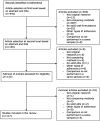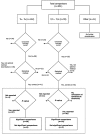A scoping review of studies comparing the medication event monitoring system (MEMS) with alternative methods for measuring medication adherence
- PMID: 27005306
- PMCID: PMC4917812
- DOI: 10.1111/bcp.12942
A scoping review of studies comparing the medication event monitoring system (MEMS) with alternative methods for measuring medication adherence
Abstract
Different methods are available for measuring medication adherence. In this paper, we conducted a scoping review to identify and summarize evidence of all studies comparing the Medication Event Monitoring System (MEMS) with alternative methods for measuring medication adherence. A literature search was performed using the open database www.iAdherence.org that includes all original studies reporting findings from the MEMS. Papers comparing methods for measuring adherence to solid oral formulations were included. Data was extracted using a standardized extraction table. A total of 117 articles fulfilled the inclusion criteria, including 251 comparisons. Most frequent comparisons were against self-report (n = 119) and pill count (n = 59). Similar outcome measures were used in 210 comparisons (84%), among which 78 used dichotomous variables (adherent or not) and 132 used continuous measures (adherence expressed as percentage). Furthermore, 32% of all comparisons did not estimate adherence over the same coverage period and 44% of all comparisons did not use a statistical method or used a suboptimal one. Only eighty-seven (35%) comparisons had similar coverage periods, similar outcome measures and optimal statistical methods. Compared to MEMS, median adherence was grossly overestimated by 17% using self-report, by 8% using pill count and by 6% using rating. In conclusion, among all comparisons of MEMS versus alternative methods for measuring adherence, only a few used adequate comparisons in terms of outcome measures, coverage periods and statistical method. Researchers should therefore use stronger methodological frameworks when comparing measurement methods and be aware that non-electronic measures could lead to overestimation of medication adherence.
Keywords: measurement methods; medication adherence; medication event monitoring system; methodology; pill count; self-report.
© 2016 The British Pharmacological Society.
Figures




Similar articles
-
Outcome measures for adherence data from a medication event monitoring system: A literature review.J Clin Pharm Ther. 2019 Feb;44(1):1-5. doi: 10.1111/jcpt.12757. Epub 2018 Sep 1. J Clin Pharm Ther. 2019. PMID: 30171815 Free PMC article. Review.
-
Concordance of Adherence Measurement Using Self-Reported Adherence Questionnaires and Medication Monitoring Devices: An Updated Review.Pharmacoeconomics. 2018 Jan;36(1):17-27. doi: 10.1007/s40273-017-0570-9. Pharmacoeconomics. 2018. PMID: 28895104 Review.
-
Correlation between adherence rates measured by MEMS and self-reported questionnaires: a meta-analysis.Health Qual Life Outcomes. 2010 Sep 13;8:99. doi: 10.1186/1477-7525-8-99. Health Qual Life Outcomes. 2010. PMID: 20836888 Free PMC article. Review.
-
Twelve months of electronic monitoring (MEMS®) in the Swedish COAST-study: a comparison of methods for the measurement of adherence in schizophrenia.Eur Neuropsychopharmacol. 2014 Feb;24(2):215-22. doi: 10.1016/j.euroneuro.2013.11.013. Epub 2013 Dec 4. Eur Neuropsychopharmacol. 2014. PMID: 24359935
-
Accuracy of Patient-reported Adherence to Glaucoma Medications on a Visual Analog Scale Compared With Electronic Monitors.Clin Ther. 2015 Sep 1;37(9):1975-85. doi: 10.1016/j.clinthera.2015.06.008. Epub 2015 Jul 9. Clin Ther. 2015. PMID: 26164785 Free PMC article.
Cited by
-
Withdrawal of antihypertensive medication in young to middle-aged adults: a prospective, single-group, intervention study.Clin Hypertens. 2023 Jan 2;29(1):1. doi: 10.1186/s40885-022-00225-2. Clin Hypertens. 2023. PMID: 36593518 Free PMC article.
-
An overview of the common methods used to measure treatment adherence.Med Pharm Rep. 2019 Apr;92(2):117-122. doi: 10.15386/mpr-1201. Epub 2019 Apr 25. Med Pharm Rep. 2019. PMID: 31086837 Free PMC article. Review.
-
Healthcare provider-led interventions to support medication adherence following ACS: a meta-analysis.Open Heart. 2017 Dec 22;4(2):e000685. doi: 10.1136/openhrt-2017-000685. eCollection 2017. Open Heart. 2017. PMID: 29344366 Free PMC article. Review.
-
Effect of Pain Coping Skills Training on Pain and Pain Medication Use for Women With Breast Cancer.J Pain Symptom Manage. 2023 Jul;66(1):70-79. doi: 10.1016/j.jpainsymman.2023.03.012. Epub 2023 Apr 6. J Pain Symptom Manage. 2023. PMID: 37028732 Free PMC article. Clinical Trial.
-
Evaluation of methods measuring medication adherence in patients with polypharmacy: a longitudinal and patient perspective.Eur J Clin Pharmacol. 2024 Jun;80(6):891-900. doi: 10.1007/s00228-024-03661-1. Epub 2024 Mar 1. Eur J Clin Pharmacol. 2024. PMID: 38427083
References
-
- Blaschke TF, Osterberg L, Vrijens B, Urquhart J. Adherence to medications: insights arising from studies on the unreliable link between prescribed and actual drug dosing histories. Annu Rev Pharmacol Toxicol 2012; 52: 275–301. - PubMed
-
- Vrijens B, Urquhart J. Methods for measuring, enhancing, and accounting for medication adherence in clinical trials. Clin Pharmacol Ther 2014; 95: 617–26. - PubMed
-
- Demonceau J, Ruppar T, Kristanto P, Hughes DA, Fargher E, Kardas P, et al. Identification and assessment of adherence‐enhancing interventions in studies assessing medication adherence through electronically compiled drug dosing histories: a systematic literature review and meta‐analysis. Drugs 2013; 73: 545–62. - PMC - PubMed
-
- Cheng CW, Woo KS, Chan JC, Tomlinson B, You JH. Assessing adherence to statin therapy using patient report, pill count, and an electronic monitoring device. Am J Health Syst Pharm 2005; 62: 411–5. - PubMed
Publication types
MeSH terms
Substances
LinkOut - more resources
Full Text Sources
Other Literature Sources

